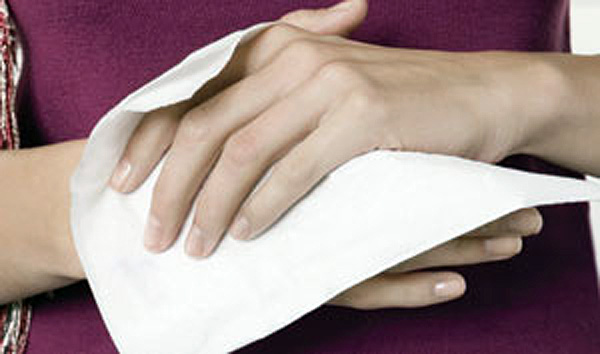
| Archive/Subscribe | TAPPI.org | Advertise | TAPPI Press Catalog | April 2015 |
Hand Drying with Paper Towels Spreads Fewer Microbes than Other Methods
New research by the University of Westminster, London, U.K., commissioned by ETS, the European Tissue Symposium (Brussels, Belgium), concludes that drying hands with single-use towels shows a lower level of airborne microbe dispersal and contamination. This could help achieve more hygienic washroom settings.
The study, undertaken by leading microbiologist Keith Redway, looked at the potential for microbial contamination from hand-drying and the potential risks for airborne microbe dispersal, particularly if hand washing is sub optimal. Four different hand drying methods and three different test models were used to determine differences between the drying methods and their capacity to disperse microbes on the hands of users to other occupants of public washrooms and into the washroom environment.
 Paper towels, a textile roller towel, a warm air dryer, and a jet air dryer were compared using three different test models—acid indicator with lemon juice, yeast, and bacterial transmission from hands when washed without soap. The peer-reviewed study was published in the March 2015 edition of the Journal of Hospital Infection.
A jet air dryer dispersed liquid from users’ hands further and over a greater range—up to 1.5 meters—than other hand drying methods. The jet air dryer also led to the greatest dispersal of microbes into the air at both near and far distances for each of the tested models. Levels recorded at the drying device revealed an average of 59.5 colonies of yeast for the jet air dryer compared with an average of just 2.2 colonies of yeast for paper towels. At a distance of 0.2 meters, jet air dryers resulted in 67 colonies compared with only 6.5 for paper towels. At a distance of 1.5 meters, the jet air dryer recorded 11.5 colonies of yeast compared with zero for paper towels.
"These findings clearly indicate that single-use towels spread the fewest microbes of all hand-drying methods," said Redway. "Cross contamination in public washrooms is a legitimate public health concern. The extent to which jet air dryers disperse microbes into the washroom environment is likely to have implications for policy guidance to facilities managers operating in a wide range of environments from sports stadia and airports to schools and hospitals."
The study also looked at the body height at which microbes were dispersed. It found the greatest dispersal was at 0.6 – 0.9 meters from the floor. This equates to the face height of small children who might be standing near a dryer when a parent is drying his or her hands.
A video version of the study is also available online.
|

